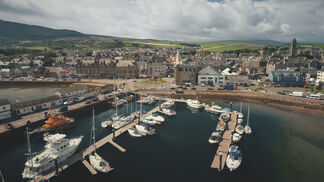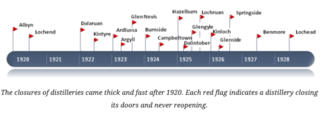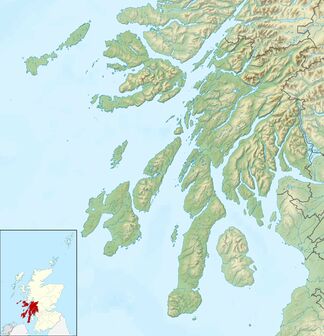Campbeltown: The Whisky Capital of the World
Certainly so for me!
Campbeltown is one of the six Whisky regions in Scotland. And it has a special significance for me. My wife, Louise, bought me a cask of whisky as a round birthday present many years ago. It was a cask of whisky from a distillery called Springbank, which is in Campbeltown. I knew I was a lucky guy getting a whole cask of whisky (around 270 Litres), but at the time I did not know just how lucky I was. I had never heard of Springbank and at the time, not many people had. When I visited my cask with a friend a year later, I started to understand what I had. And I got so drunk in the tasting room, I bought a second cask. And when Springbank announced they were stopping cask sales, I bought my third and fourth casks, which were the last two Springbank ever sold. So this leads me to write about this wonderful and quite beautiful little town in Scotland that became a whole region in its own right.
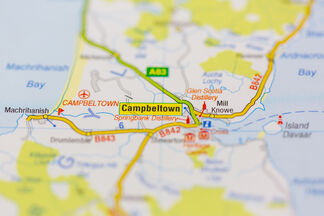
Where is Campbeltown?
A Long Way from Anywhere!
Campbeltown is a small town (referred to affectionately as “The Wee Toon”) on the East side of Kintyre, facing towards Arran and the Scottish mainland. Kintyre is the part of Scotland that sticks out to the South West and was made famous both by Whisky and Paul McCartney who has a farm (High Park Farm) there and wrote the song “Mull of Kintyre”. See the map here for the location of Campbeltown.
If travelling by road, you have to head north of Glasgow and take a left turn as you reach Loch Lomond, and then drive down Kintyre – a beautiful drive with great views, but a long one of a few hours. You can also fly into the small airfield at nearby Machrihanish, but flights are often cancelled due to bad weather. One of the best routes is by ferry, which goes from Ardrossan near Glasgow, round the Isle of Arran and directly into The Wee Toon.
Campbeltown is a town and former royal burgh in Argyll and Bute, Scotland. It lies by Campbeltown Loch. Due to its location, it became an important centre for Scotch whisky, and a busy fishing port. It is not a large town. The 2018 population estimate was 4,600 indicating a reduction since the 2011 census.
It is also local to a wonderful, but extremely difficult, golf course at Macrihanish. Between the first tee and the fairway lies a small cove with a beach. One of the largest bunkers I have ever seen! And a challenge that will challenge the nerves of even the best golfers!
Campbeltown was not the town’s original name. The place itself was established in 1597 by act of parliament, and began to be settled in 1607. It was known as Lochhead until the mid-19th century when the name Campbeltown was invented, rather immodestly, by the local lairds, the Campbells!
A single town is a Whisky region?
With a History like this, it deserves to be!
Well at one time, Campbeltown was the home of over 30 distilleries. In fact most of the town buildings were producing whisky at some point or other. Currently there are only 3 in production – the minimum number required for a Whisky region, with a 4th being built.
Being so far away from the mainland, with ample supply of water, peat and barley, illicit whisky was produced in Campbeltown for years. There are no records of how many distilleries there were then and how much whisky was made, but the earliest reference to whisky being produced in Campbeltown is 1591.
Having a port allowed the distillers to ship whisky easily. But the first registered distillery in Campbeltown was The Campbeltown Distillery in 1815. In 1823 the Caledonian Distillery was opened. In 1824, four more opened (Kinloch, Lochhead, Longrow and Meadowburn). 1825 saw Burnside, Dalaruan, Hazelburn and Rieclachan open their doors. And throughout 1826 and 1827, Union, Highland, MacKinnon and Glenramskill were opened.
In 1828 Springbank came along and after that, Kintyre, Lochside, Springside, West Highland, Dalintober, Meadowbank, Glen Scotia (1832), Broombrae, Lochruan, Drumore, Mossfield, Thistle, Toberanrigh, Glenside, Albyn, Argyll, Benmore, Glengyle, Glen Nevis, and Ardlussa.
It is said that Campbeltown focussed on quantity and not quality, which led to the closure of most of the distilleries. But it has certainly put that reputation to bed as it is now home to some of the most respected, and most sought after whiskies. The 3 distilleries in operation today are Glengyle, Glen Scotia and Springbank. The 4th distillery is awaiting final planning permission before construction can start. It is called Dal Riata.
As Whisky continues to break record prices in auctions, Whisky from Springbank at least is being "flipped" (bought and the instantly auctioned) for prices as much as 10 times their recommended retail price.
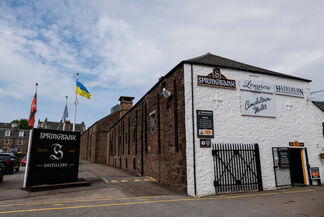
Campbeltown Distilleries Today
The Remaining Three
With such a history of distillery closures, it is a tad, but not completely surprising that the three that remain are immensely successful. And that a fourth is being built. The last twenty to thirty years has been a real tide turn in the fortunes of Campbeltown. All three distilleries are producing extremely high quality – and high value – whiskies.
Springbank is probably the best known of the 3 distilleries. It was founded by the William Reid Jr Ltd in 1828 and sold to the Mitchell Brothers, John and William, in 1837. It is on the site of an illicit distillery that was owned by Archibald Mitchell (John and William’s father). The site is reputed to be an old chapel. It produces 3 core products – one carrying the original distillery name (Springbank) the other two are named after closed distilleries (Longrow and Hazelburn). The 3 products are quite different in their production and taste. Longrow is a fairly heavily peated whisky, Hazelburn is a smooth un-peated whisky, and Springbank is slightly peated. Springbank remains Mitchell family owned and is one of the few distilleries in Scotland that manages every stage of whisky production in-house.
Glengyle was founded in 1872 by William Mitchell after an argument with his brother John, reputedly about sheep. The Mitchells were both distillers and farmers. He built the distillery right next to Springbank. It actually closed down in 1925 as the global popularity and consumption of whisky declined and the world economy was in a downward spiral. The entire spirit stock was auctioned off. The buildings were used by the local gun club, and also by an agricultural company, which at least helped to maintain the structures. The buildings were eventually purchased back by the Mitchell family in 2000 and the distillery re-opened in 2004 producing a whisky called Kilkerran. Kilkerran whisky offers a range from heavily peated to quite smooth. Well worth a try!
Glen Scotia, originally called just Scotia, was established in 1832 by the town’s Dean of Guild James Stewart and Provost John Galbraith. On March 20 1930, the last production batch was finished at Scotia before the distillery fell silent, due to the economic disasters at the time. The Bloch Brothers bought the distillery in 1933 and reopened as Glen Scotia. Then in 1984 Glen Scotia fell silent yet again for five years. 1989 saw an upturn in fortune once more and Glen Scotia opened again under the Gibson ownership.
The distillery changed hands a number of times, and in 2014 was bought by the Loch Lomond Group who have invested and developed this legendary brand, increasing capacity, opening warehouses and creating a visitor centre. Today, Glen Scotia continues to thrive at the heart of the “whiskiest” place in the world. It has won several awards recently and is a brand any whisky lover should have in their cabinet (better, in their glass).
As you can see, the Mitchell family have played - and continue to play - a significant role in Campbeltown Whisky. Owning today two of the three Campbeltown distilleries and with a history back to the illicit still days.

Campbeltown – the birthplace of Japanese Whisky?
Read on .....
Masataka Taketsuru (1894–1979) was a Japanese chemist and businessman. He is known as the founder of Japan's whisky industry and Nikka Whisky Distilling. Born to a family that had owned a sake brewery since 1733, he traveled to Scotland in 1918 to study organic chemistry and distilling. He then returned to Japan establishing a whisky distillery at Suntory and founded his own distilling company, Nikka Whisky, in 1934.
In April 1919, Taketsuru began his apprenticeship at Longmorn distillery in Strathspey, Scotland, and then in July at James Calder & Co.'s Bo'ness distillery in the Lowlands region. On 8 January 1920, he married Jessie Roberta "Rita" Cowan of Middlecroft, Kirkintilloch, despite opposition from both their families. They lived in Campbeltown and his apprenticeship began in May 1920 at Hazelburn distillery before moving to Japan later in November 1920. It was at Hezelburn that Taketsuru really got involved in the process of making whisky - both learning, but also suggesting improvements.
Masataka took back with him 2 notebooks filled with his notes on the whisky distilling process. They are still preserved in a museum in Japan. They are probably the most important documents in Japanese whisky making history.
So one could say that Japanese Whisky grew out of Campbeltown!
An Urban Myth about Kintyre
Or Could It Be True?
Curiously, if you look at the map and in particular the shape of Kintyre, those of you with an imagination may see something that led to be an Urban Myth. Known as the Mull of Kintyre test it is said to have been an unofficial guideline used by the British Board of Film Classification (BBFC) to decide whether an image of a penis could be shown on screen or not.
According to the myth, the BBFC would not permit the general release of a film or video if it depicted a penis erect to the point that the angle it made from the vertical was higher than that of the peninsula of Kintyre in Argyll and Bute on maps of Scotland.
The BBFC has denied that any such "test" existed, and maintain it is merely a humorous rumour. The Mull of Kintyre test was said to have first been used for the release of the controversial erotic historical drama film Caligula in 1979.
I will let you decide if it is truth or myth.
